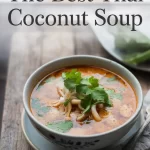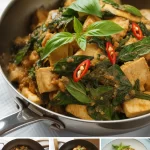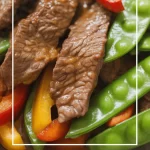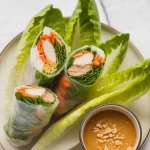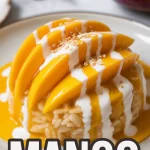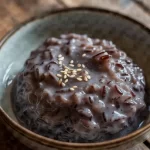I absolutely adore this Panang curry paste recipe because it feels like a vibrant, aromatic journey through authentic Thai flavors right in my own kitchen, and it’s seriously impressive to craft something so rich and complex from scratch. Plus, the blend of spices with fresh lemongrass and kaffir lime zest hits all the right notes, making it a perfect base for countless delicious meals that never fail to wow my friends and family.

Homemade Panang Curry Paste is one of my favorite things to make because it blends the warmth and spice of 10 (yes, 10) dried red chili peppers with the fragrant and almost sweet notes of lemongrass and galangal. Toasted coriander and cumin seeds add their oh-so-nutty flavors, while the shrimp paste and garlic bring a savory, almost addictive quality to the whole affair.
Ingredients

Red chili peppers, when dried, provide warmth and a strong vivid color.
They are also an excellent source of vitamin C.
Coriander Seeds: Offers a nutty, citrusy flavor; helps with digestion.
Cumin Seeds: Warm and earthy; carries antioxidants.
And promotes metabolism.
Galangal is aromatic and spicy; it has anti-inflammatory properties that support digestion.
Lemongrass has a citrusy scent and aids in digestion.
It is rich in antioxidants.
Cilantro Root: Pungent and earthy; boosts flavor, detoxifying power.
Fermented shrimp: Salty umami punch; protein and mineral powerhouse.
Ingredient Quantities
- 10 dried red chili peppers, seeds removed and soaked in warm water
- 1 teaspoon salt
- 1 tablespoon coriander seeds, toasted
- 1 teaspoon cumin seeds, toasted
- 1 teaspoon black peppercorns
- 1 tablespoon lemongrass, finely chopped (white part only)
- 2 tablespoons galangal, peeled and sliced
- 2 tablespoons cilantro root, chopped
- 5 cloves garlic, peeled
- 2 shallots, peeled and chopped
- 1 tablespoon shrimp paste
- 1 teaspoon kaffir lime zest, finely grated
Instructions
1. Begin by taking the soaked red chili peppers and draining them well. Pat them dry using a paper towel.
2. Pound or grind the toasted coriander seeds, cumin seeds, and black peppercorns into a fine powder using a mortar and pestle or a spice grinder. Set aside.
3. In the mortar, combine the chili peppers that have been drained with salt. Pound them into a smooth paste. If you’re using a blender, add a little water to help it along, but keep the liquid to a minimum for best results.
4. In the mortar, add the lemongrass to the paste, and keep pounding or puréeing until it’s well mixed and smooth.
5. Combine the sliced galangal and cilantro root with the mixture, pounding until fully combined.
6. Combine the garlic cloves and the chopped shallots with the paste. Continue to pound or blend the ingredients until they are all consistent and there are no chunks remaining.
7. Ensure an even distribution of the prepared spice powder (from step 2) within the paste by mixing it in well.
8. Slowly incorporate the shrimp paste and pound or blend until it’s completely combined with the paste.
9. Finally, incorporate the finely grated zest of the kaffir lime into the mix, and blend it well so that the oils and fragrance are completely melded into the paste.
10. Keep Panang curry paste in an airtight container in the refrigerator, where it will last for up to one week. For longer storage, pop the paste into the freezer. It’s best to portion it out first; the paste won’t freeze well in one large block.
Equipment Needed
1. Mortar and pestle or spice grinder
2. Blender (optional)
3. Paper towels
4. Knife
5. Cutting board
6. Airtight container
7. Grater (for zesting kaffir lime)
FAQ
- What can I use if I can’t find cilantro root?If you cannot find cilantro root, you may use the stems of fresh cilantro as a substitute.
- Is there a substitute for galangal?Galangal can be substituted with fresh ginger, but the flavor will be different and slightly off.
- How spicy is this Panang curry paste?The heat level is dependent on the kinds of dried red chili peppers that are used. Reducing the seeds and soaking them elicits a milder flavor profile.
- What’s the best way to store leftover curry paste?Any leftover paste should be stored in an airtight container in the refrigerator. It will last for up to a week in there. For longer storage, you can freeze it.
- Can I use lime juice instead of kaffir lime zest?The unique flavor of kaffir lime zest is preferred, but a small amount of lime zest and juice can replace it if necessary.
- Is there a vegetarian alternative to shrimp paste?Fermented soybean paste can act as a substitute, though not an identical one, for soybean paste made from the traditional combination of legumes. Earth’s Choice Miso is made from organic soybeans and is a 98% antimicrobial cultured food. The 2% of the product that is not organic acts as a leavening agent. Fermented organisms are essential because they give off enzymes that break down the macromolecules necessary for miso’s flavor profile.
- Can ground spices be used instead of whole coriander and cumin seeds?Although the freshest flavor comes from whole seeds toasted just before use, it is sometimes necessary to resort to using pre-ground spices. When using them, slightly diminish the amounts called for in a recipe to compensate for the loss of flavor with pre-ground spices.
Substitutions and Variations
If you don’t have dried red chili peppers, you can use fresh red chili peppers and slightly reduce the soaking time. Or, use dried cayenne peppers for a similar level of heat.
If using coriander seeds: Use coriander powder, but use about half the amount.
Use ginger as a substitute for galangal, but note that the flavor will differ somewhat.
Cilantro stems have a flavor profile akin to that of cilantro roots, though slightly less intense. For an equally flavorful result, don’t be shy about using enough stems to round out the dish. Even when you factor in the possibility of using thicker, barkier stems, this substitution won’t run afoul of any traditional Chinese or Thai recipes calling for cilantro root.
In place of the zest from a kaffir lime, use the zest of a lime mixed with a small amount of lemon zest to replicate the singularly citrus flavor.
Pro Tips
1. Toast the spices: Make sure the coriander seeds and cumin seeds are toasted evenly until they are aromatic. This will enhance their flavor and add depth to the curry paste.
2. Freshness matters: Use the freshest ingredients you can find, especially for the lemongrass, galangal, and cilantro root. Their freshness adds vibrant flavors to the paste.
3. Shrimp paste tip: If possible, toast the shrimp paste lightly wrapped in foil over a flame or in a hot pan before adding it to the paste. This will mellow out its pungency and elevate its umami richness.
4. Consistency is key: Achieve a smooth paste by ensuring all ingredients are well-pounded and no chunks remain. This is crucial for a balanced distribution of flavors and a smooth texture in your curry.
5. Freeze in portions: For convenience, freeze the prepared paste in small portions using an ice cube tray. This way, you can easily take out just the amount you need without thawing the entire batch.

Panang Curry Paste Recipe
My favorite Panang Curry Paste Recipe
Equipment Needed:
1. Mortar and pestle or spice grinder
2. Blender (optional)
3. Paper towels
4. Knife
5. Cutting board
6. Airtight container
7. Grater (for zesting kaffir lime)
Ingredients:
- 10 dried red chili peppers, seeds removed and soaked in warm water
- 1 teaspoon salt
- 1 tablespoon coriander seeds, toasted
- 1 teaspoon cumin seeds, toasted
- 1 teaspoon black peppercorns
- 1 tablespoon lemongrass, finely chopped (white part only)
- 2 tablespoons galangal, peeled and sliced
- 2 tablespoons cilantro root, chopped
- 5 cloves garlic, peeled
- 2 shallots, peeled and chopped
- 1 tablespoon shrimp paste
- 1 teaspoon kaffir lime zest, finely grated
Instructions:
1. Begin by taking the soaked red chili peppers and draining them well. Pat them dry using a paper towel.
2. Pound or grind the toasted coriander seeds, cumin seeds, and black peppercorns into a fine powder using a mortar and pestle or a spice grinder. Set aside.
3. In the mortar, combine the chili peppers that have been drained with salt. Pound them into a smooth paste. If you’re using a blender, add a little water to help it along, but keep the liquid to a minimum for best results.
4. In the mortar, add the lemongrass to the paste, and keep pounding or puréeing until it’s well mixed and smooth.
5. Combine the sliced galangal and cilantro root with the mixture, pounding until fully combined.
6. Combine the garlic cloves and the chopped shallots with the paste. Continue to pound or blend the ingredients until they are all consistent and there are no chunks remaining.
7. Ensure an even distribution of the prepared spice powder (from step 2) within the paste by mixing it in well.
8. Slowly incorporate the shrimp paste and pound or blend until it’s completely combined with the paste.
9. Finally, incorporate the finely grated zest of the kaffir lime into the mix, and blend it well so that the oils and fragrance are completely melded into the paste.
10. Keep Panang curry paste in an airtight container in the refrigerator, where it will last for up to one week. For longer storage, pop the paste into the freezer. It’s best to portion it out first; the paste won’t freeze well in one large block.




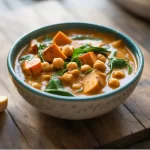
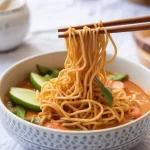

![Thai Coconut Soup [Coconut Milk Soup] Recipe](https://bangkokbowl.com/wp-content/uploads/2025/06/Collage_Thai-Coconut-Soup-Coconut-Milk-Soup-_1751036922-150x150.webp)
